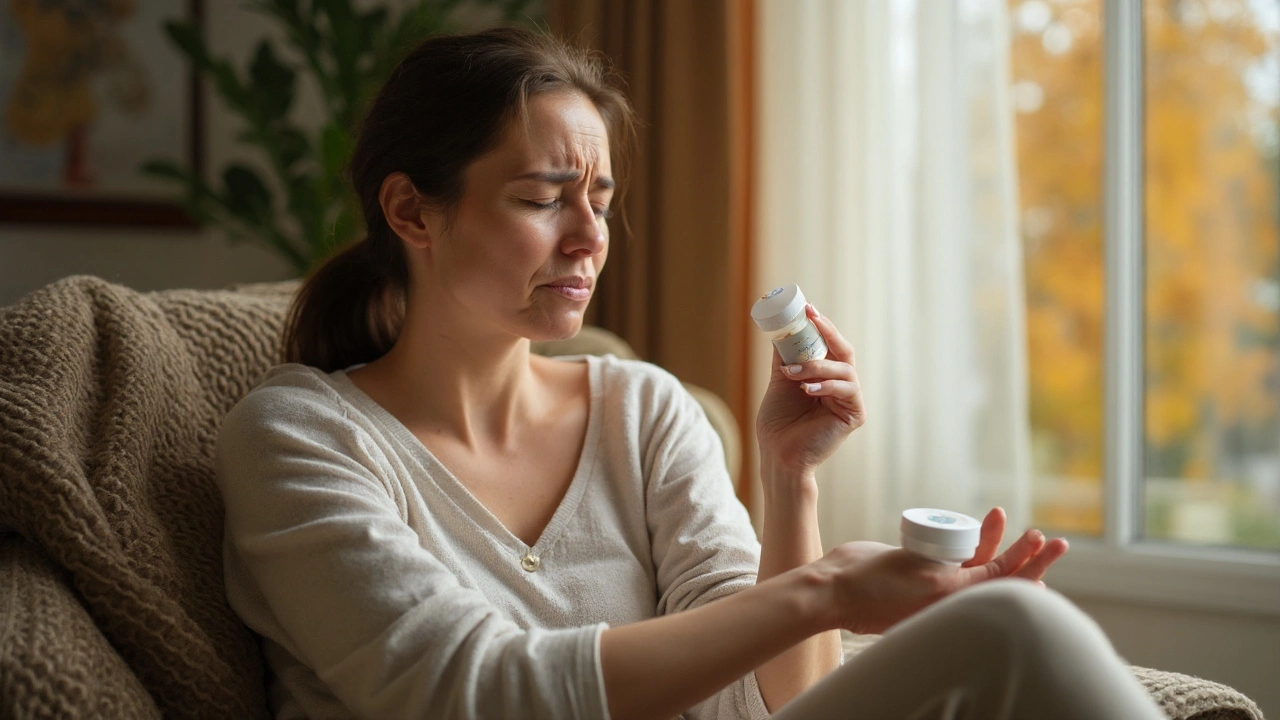Fibromyalgia is a chronic pain syndrome characterized by widespread musculoskeletal pain, fatigue, and heightened pain sensitivity. While most people think of it as a purely musculoskeletal condition, the skin often bears the brunt of the disease. Patients report mysterious rashes, relentless itching and an almost electric response to light touch. This guide walks you through what’s really happening under the skin and gives you tools to feel better.
How Fibromyalgia Impacts the Skin
Two core mechanisms drive the dermatological fallout of fibromyalgia skin rash:
- Central sensitization is a neurophysiological process where the central nervous system amplifies pain signals, leading to increased sensitivity to normally non‑painful stimuli. This means the brain treats a gentle brush as a painful sting.
- Small fiber neuropathy is a damage to the tiny nerve fibers that control pain, temperature and itch sensations. Even if the nerves look fine under a microscope, their function is compromised.
Both pathways raise the threshold for irritation, making everyday triggers-like a sweater seam or a mild temperature shift-feel like a flare.
Typical Skin Manifestations
Not every fibromyalgia patient gets skin issues, but when they appear they tend to fall into a handful of recognizable patterns.
| Symptom | Typical Appearance | Common Triggers | First‑Line Management |
|---|---|---|---|
| Skin rash | Red, sometimes patchy erythema; can be urticarial or eczematous | Heat, stress, certain fabrics, medications | d>Cool compresses, antihistamines, gentle moisturizers |
| Itching (pruritus) | Dry, flaky patches; may develop excoriations from scratching | Dry air, soaps, night‑time heat | Emollient creams, topical menthol, oral gabapentin |
| Allodynia | Localized tenderness; skin may appear normal | Light touch, clothing seams, temperature change | Desensitizing creams (lidocaine), gentle stretching, cognitive‑behavioral coping |
Why Rashes Appear: The Biological Backdrop
Rashes in fibromyalgia are not a classic allergic reaction. Instead, they emerge from a cascade of immune and neuro‑inflammatory events.
- Mast cells are immune cells that sit just beneath the skin surface and release histamine, tryptase and a host of cytokines when activated. In fibromyalgia, chronic stress can keep these cells on a low‑grade alert, spilling tiny amounts of histamine that cause redness without a full hives episode.
- Cytokines such as interleukin‑6 (IL‑6) and tumor necrosis factor‑α (TNF‑α) are elevated in many patients. They heighten vascular permeability, making skin vessels leaky and giving rise to that flushed look.
- When small fiber neuropathy co‑exists, the damaged nerves release neuropeptides like substance P, further stoking inflammation and itching.
Think of it as a slow‑burning ember under the skin-visible as a rash, felt as itch, and amplified by the brain’s heightened alarm system.
Managing Itching and Sensitivity
There’s no one‑size‑fits‑all cure, but a layered approach works for most patients.
- Topical relief: Look for moisturisers containing ceramides, colloidal oatmeal or colloidal zinc. For intense itch, a 1% lidocaine gel can numb the area for a few hours.
- Oral medications: Low‑dose tricyclic antidepressants (e.g., amitriptyline) reduce central sensitization. Gabapentin or pregabalin modulate nerve firing and often calm both pain and itch.
- Supplements: Vitamin D deficiency is common in fibromyalgia sufferers; correcting it (target 30-50ng/mL serum 25‑OH) can lessen skin inflammation.
- Lifestyle tweaks: Keep indoor humidity around 45%. Choose breathable cotton over synthetics, and avoid hot showers-lukewarm water preserves the skin barrier.
- Stress management: Mind‑body practices (guided meditation, gentle yoga, breathing exercises) lower cortisol, which in turn calms mast‑cell activity.

When to Seek Professional Help
If any of the following occur, book an appointment promptly:
- Rash spreads rapidly or develops pus - could signal infection.
- Itch becomes nightly and disrupts sleep - may need prescription‑strength antihistamines or neuropathic agents.
- Skin changes are accompanied by new joint swelling or fever - rule out autoimmune overlap like lupus.
Dermatologists can perform a skin biopsy to check for mast‑cell infiltration, while neurologists may run a skin‑punch biopsy to confirm small fiber neuropathy.
Related Topics to Explore
If you found this article useful, you might also be interested in:
- "Fibromyalgia and Sleep" - how poor rest fuels skin flare‑ups.
- "Dietary Triggers in Fibromyalgia" - the role of gluten, nightshade veggies and sugar.
- "Mind‑Body Techniques for Pain Management" - practical exercises you can start today.
Quick Take
- Fibromyalgia can cause rashes, itching and allodynia through central sensitization, mast‑cell activation and small‑fiber neuropathy.
- Key skin triggers are heat, stress and irritating fabrics.
- A combined regimen of moisturisers, targeted medications, vitamin D optimisation and stress reduction usually yields the best relief.
- Seek medical advice for rapidly spreading rashes, persistent night‑time itch or any signs of infection.
Frequently Asked Questions
Why does fibromyalgia cause skin rashes?
Rashes arise from a mix of heightened central sensitization, low‑grade mast‑cell activity and inflammatory cytokines. The nervous system amplifies normal skin signals, while immune cells release histamine and other mediators that cause redness and itching.
Is it normal to feel pain from light touch?
Yes. The condition is called allodynia and is a hallmark of central sensitization. Even a gentle brush can fire pain pathways, making the skin feel sore or burning.
Can vitamins help with skin symptoms?
Vitamin D deficiency is common in fibromyalgia and correlates with increased skin inflammation. Restoring serum levels to 30‑50ng/mL often eases itching and reduces rash frequency.
What over‑the‑counter creams are safest?
Look for fragrance‑free moisturisers with ceramides or colloidal oatmeal. For rescue, a 1% lidocaine gel or a menthol‑based cooling cream can temporarily calm itch without causing systemic side effects.
When should I see a dermatologist?
If a rash spreads quickly, becomes painful, oozes pus, or is accompanied by fever, schedule a dermatologist visit. A skin biopsy can clarify whether mast‑cell proliferation or small‑fiber loss is driving your symptoms.

18 Comments
Graham Moyer-StrattonSeptember 26, 2025 AT 01:37
This is just another way for the medical industry to profit off our suffering. They don't want to fix the root cause-just sell you more drugs. The real problem is glyphosate in our food and 5G radiation. You think your skin is reacting to stress? It's the chemtrails.tom charltonSeptember 27, 2025 AT 12:45
Thank you for this meticulously researched and clinically grounded overview. The integration of neurophysiological mechanisms with practical dermatological management is both rare and deeply appreciated. I will be sharing this with my patients immediately.Jacob Hepworth-wainSeptember 28, 2025 AT 22:26
I’ve been dealing with this for years. The lidocaine gel was a game changer. Also, switching to cotton shirts made a huge difference. Don’t underestimate how much fabric matters. You’re not crazy-it’s real.anant ramSeptember 30, 2025 AT 20:46
I think, we must understand, that fibromyalgia, is not just a disease, it is a systemic imbalance, and the skin, is the mirror, of our inner chaos, and if we ignore the emotional trauma, the rashes, will never go away, and yes, I mean it, the trauma, the repressed feelings, the unspoken pain, it all shows up on the skin, you know?king tekken 6October 1, 2025 AT 11:38
so i read this whole thing and like… i think its kinda right but also kinda wrong? like i had this rash last year and it went away after i stopped eating gluten and started doing reiki. also i think the government is hiding the real cause. maybe its fluoride? or vaccines? idk but i feel yaDIVYA YADAVOctober 2, 2025 AT 11:17
This is all a distraction. The real issue is that Big Pharma and the WHO are working together to suppress natural healing methods. Did you know that vitamin B12 injections and Indian herbal remedies like ashwagandha have been proven to reverse fibromyalgia symptoms? No? Because they don’t want you to know. The FDA banned these in 1987 under pressure from pharmaceutical lobbyists. You think your rash is from stress? It’s from the poison they put in your water.Kim ClapperOctober 2, 2025 AT 14:18
I find it deeply concerning that this article presents such a sanitized, clinical narrative. Where is the acknowledgment of the psychological trauma underlying this condition? Where is the discussion of how modern society’s relentless demands have fractured our nervous systems? You offer creams and vitamins, but you ignore the existential collapse.Bruce HennenOctober 3, 2025 AT 23:28
The article correctly identifies central sensitization and small fiber neuropathy. However, it omits the critical role of mitochondrial dysfunction in fibromyalgia-related skin symptoms. Studies from 2019–2023 show ATP depletion in cutaneous nerves correlates directly with allodynia severity. Supplementing with CoQ10 and riboflavin improves outcomes. This oversight is unacceptable.Jake RuhlOctober 4, 2025 AT 15:42
okay so like i got this rash and it burned like fire and i thought it was a spider bite but then i realized its fibromyalgia and i started crying because no one gets it and then i drank a whole bottle of wine and slept for 14 hours and woke up and the rash was gone for a minute but then it came back and now im scared to wear clothes and i think the earth is shaking because of the vaccines and i just want someone to hug meChuckie ParkerOctober 4, 2025 AT 15:54
If you're getting rashes from fabric, you're not dealing with fibromyalgia. You're dealing with poor hygiene or an allergic reaction. Stop blaming your nervous system. Wash your clothes. Use unscented detergent. Stop drinking soda. This isn't rocket science.Michael SegbawuOctober 5, 2025 AT 14:28
they say its all in your head but then they give you a list of meds to fix it so which is it brain glitch or real disease i mean if its real why dont they just fix the nerves why do they need to sell you gabapentin for life its just a scamAarti RayOctober 7, 2025 AT 11:52
i had this issue after i moved to usa from india and i thought it was the cold but then i read about fibro and it made sense. here people use so many chemicals in soap and laundry and my skin just broke out. i started using homemade neem paste and it helped a lot. also dont wear polyesterAlexander RolsenOctober 9, 2025 AT 08:19
You call this a guide? This is a marketing brochure for pharmaceutical companies. You mention gabapentin like it’s a miracle cure, but you ignore the fact that 70% of patients report worsening depression, brain fog, and weight gain. You’re not helping-you’re enabling dependency.Leah DoyleOctober 9, 2025 AT 22:09
This is the most accurate thing I've read about my skin symptoms. I’ve been told I'm imagining the itching for years. Thank you for validating that this is real. I started using colloidal oatmeal baths and I actually slept last night. 🙏Alexis MendozaOctober 11, 2025 AT 08:56
It’s funny how we label things. We say 'fibromyalgia rash' like it's a separate thing. But what if the skin isn't the problem? What if it's just the messenger? The body is screaming because the mind is broken. Maybe the cure isn't in creams or pills, but in learning how to listen.Michelle N AllenOctober 11, 2025 AT 15:42
I read this and I'm just like... why does this even matter? I mean, I get the rashes, I get the itch, but honestly, I just take Benadryl and move on. This article feels like overkill. Like, I don't need a 10-page breakdown to know I shouldn't wear wool.Madison MaloneOctober 12, 2025 AT 19:04
I’ve been living with this for 12 years. The thing that helped me most was not the meds, not the creams, but finding a community of people who actually get it. You’re not alone. Your skin isn’t betraying you-it’s trying to tell you something. Listen gently.Craig HartelOctober 13, 2025 AT 00:26
This is exactly what I needed to hear. I’ve been avoiding dermatologists because I thought they’d just say 'it’s stress.' But now I know there’s science behind it. I’m booking a skin biopsy next week. Thank you for giving me hope.